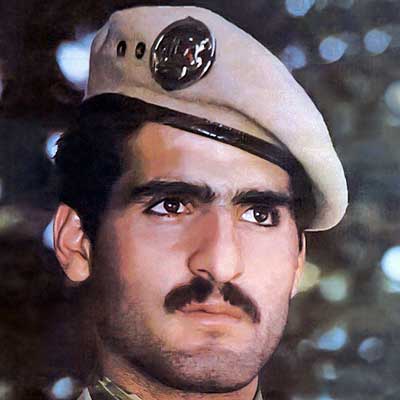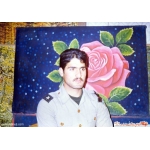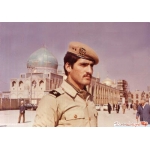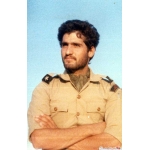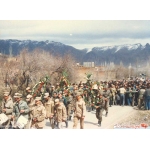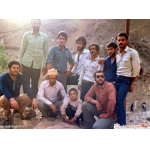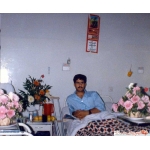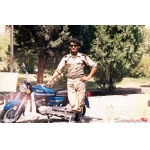Ahmadi Bighash, Davoud
Masoumeh Abedini
260 بازدید
Davoud Ahmadi Bighash (1963-1987) served as the commander of the Special Reconnaissance Battalion of the 58th Zolfaqar Division.
He was born on May 22, 1963, in Tureh, Arak. Even before attending primary school, he learned to recite the Holy Quran. He finished primary and elementary school by 1977 in the village of Zanganeh, near Malayer. He then moved to Arak to attend high school. To cover his tuition, Ahmadi Bighash worked as a construction worker during the holidays.
His formative years coincided with the people’s fervent movement against the Pahlavi regime. Despite his youth, Ahmadi actively distributed pamphlets containing Imam Khomeini's messages and remarks and participated in public demonstrations.
In 1981, Ahmadi Bighash obtained the diploma, and in November of the same year he was admitted to the Officers' Academy In 1983, he transferred to Shiraz to take the specialized commando training which allowed him to be promoted to the rank of second lieutenant. He then deployed to the southern operational region, where he immediately took command of the first company of the Qods Battalion.
On January 8, 1985, Ahmadi Bighash completed a three-month training course in mountain warfare, amphibious operations, and desert survival, where he topped his class On June 23, 1985, he was transferred to Ahvaz. As a result of the competency, bravery, valor, and skills he demonstrated during training, he was appointed Commander of the Special Reconnaissance Battalion of the 58th Commando Division Zolfaqar.
On September 6, 1985, Ahmadi Bighash and his unit were deployed to Changuleh, a region southeast of Mehran. Their mission involved maintaining defensive lines and conducting reconnaissance in the area. His sophisticated and independent unit managed to protect the military vehicles passing the Mehran-Dehloran Road. Ahmadi Bighash would personally lead the patrols himself on this daily and nightly mission. Oftentimes, intense skirmishes would break out between his unit and the Baathist army or with members of the People’s Mojahedin Organization (Munafaqeen). As a result of these skirmishes, he sustained multiple injuries.
On April 5 and May 10, 1985, Ahmadi Bighash and his unit successfully resisted two heavy offensives conducted by Baathist soldiers. Their bravery prevented the fall of the operational area and boosted the morale of the Iranian forces. In recognition of these acts of bravery, he was promoted to first lieutenant on November 6, 1986. In addition, on January 30, 1987, as the commander of the Special Reconnaissance Battalion of the 58th Zolfaqar Division, he participated with his unit in Operation Karbala 6, which led to another injury After receiving treatment, he promptly returned to the frontlines.
On December 3, 1987, while conducting reconnaissance behind enemy lines, Ahmadi Bighash and his comrades found themselves surrounded by Iraqi forces As he attempted to break the encirclement he was hit in the leg. Consequently, he was transferred to Tehran to receive treatment. After being discharged from the hospital, despite the doctor’s orders to rest for a few days, he returned to the frontlines in Ahvaz. His bravery and dedication earned him a year and a half of seniority as the commander of the Iranian Army Ground Forces.
In 1988, he tied the knot, but just a few days later, he returned to the frontlines. He built a sports club (known as Zurkhaneh) next to the prayer hall in the operational area with the hopes of promoting athletic and cultural activities.
During a reconnaissance mission in the Dasht-e Soumar region, Ahmadi Bighash, along with the headquarters commander and the Zolfaqar Division commander, visited the area multiple times to make a more informed strategic decision about their operation. Tragically on March 5, 1988, during one of these reconnaissance missions, his group came under heavy enemy fire. Ahmadi Bighash was struck in the head by shrapnel and attained martyrdom. The next day, the body of Davoud Ahmadi Bighash was transferred to Arak and laid to rest in his birthplace, the village of Tureh.
After his martyrdom, Major General Sayyad Shirazi, then-commander of the Iranian Army's Ground Forces, expressed in a message: "This martyr was a valuable asset for the Islamic Republic of Iran and our sacred Islamic system. God willing, his sacrifice will give rise to hundreds of other virtuous and noble people, and his commitment, bravery, and devotion to the Islamic leadership will serve as a model for the youth".
In his will, Ahmadi Bighash wrote: "Fighting for the sake of God is sweet, and martyrdom is even sweeter. Martyrdom is a great honor that only those who have gone and met their God with bloodied faces know its joy and grandeur... My dear ones do not mourn my loss and say, 'Poor fellow, he is gone,' because martyrdom is the best way to leave this transient world. Everyone dies, each in their way, and [martyrdom] is the best and most complete way of death".[1]
[1] A summary of an article published in the Sacred Defense Encyclopedia, Vol. 1, Tehran, The Center of Encyclopedia of the Sacred Defense Research Institute, 2011, Pp. 365-367.


